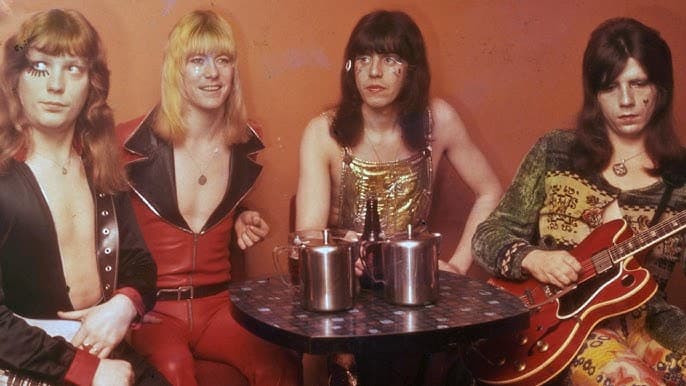
The mid-1970s was a vibrant era marked by bold soundscapes and flamboyant fashion, and few bands captured this spirit quite like Sweet. Known primarily for their electrifying hits like “Ballroom Blitz” and “Fox on the Run,” the band surprised fans by daring to cover a Motown classic in a way that was anything but expected. Their audacious rendition of the Four Tops’ 1966 hit, “Reach Out I’ll Be There,” transformed the soulful original into a roaring, hard-rock anthem that blasted through stadium speakers and left an indelible mark on rock history.
First released on the 1974 European pressing of the album Desolation Boulevard and subsequently used as the B-side of the hugely popular “The Ballroom Blitz” single in several markets, Sweet’s take on the track did not soar to top chart spots as an A-side in major territories like the UK or US. However, its presence on the album and single ensured widespread exposure to millions of listeners worldwide. This daring selection was a vital piece of the Sweet legacy, showcasing not only their musical prowess but also their fearlessness in reimagining a beloved classic.
The original version, crafted by the legendary Holland-Dozier-Holland songwriting team, is a pillar of soul music—a frenetic and deeply emotional call of loyalty and comfort, carried by Levi Stubbs’ passionate and soaring vocals. In stark contrast, Sweet’s interpretation uprooted the intimate soul vibe of Hitsville U.S.A. and thrust it into the thunderous realm of hard rock. This was no mere homage; it was a full-blown sonic reinvention.
Brian Connolly, lead vocalist of Sweet, explained, “We wanted to smash the original open and throw it into our world—not shy away from who we were or the power our music could hold.”
While the original lyrics still conveyed steadfast support and dedication, the emotional context was drastically different. Where Stubbs’ voice teetered on the edge of heartfelt anguish, Connolly’s delivery was a larger-than-life, glam-rock proclamation, booming confidently from colossal stages. This cover was a deliberate move by the band to transcend the bubblegum pop image tied to their early work with producers Nicky Chinn and Mike Chapman. It affirmed their evolution into a serious and respected hard rock act.
The track’s unforgettable impact springs largely from its unapologetic heaviness. The guitars, wielded by Andy Scott, were thick, distorted, and crushing, while Mick Tucker propelled the rhythm with relentless force—turning the nimble, elegant Motown beat into a powerful, almost metal stomp. The original’s delicate flute intro was ambitiously cast aside, replaced by a tidal wave of sound that commanded attention from the very first note.
Andy Scott reflected on the recording process, “We weren’t interested in polite or pretty on this one. This was about taking a classic and making it loud, raw, and unmistakably ours.”
This bold artistic choice solidified Sweet’s reputation as one of the most dynamic and versatile bands of their time. The sheer wall of sound they created not only reignited the song but transported listeners back to an era of flared trousers, platform boots, and amps cranked to eleven. It proved that with the right mixture of skill and audacity, a timeless song could be reborn and embraced by an entirely new generation.
Mick Tucker, the band’s drummer, shared, “Putting that drum beat down was our way of saying, ‘This is who we’ve become—raw, intense, and unstoppable.’ To us, it was more than a cover. It was a declaration.”
More than a cover, it was a bold rock statement that challenged expectations and redefined what a hard rock band could achieve. It was proof that Sweet, often pigeonholed by critics, possessed the courage and musical depth to cross genres and leave a lasting impact.
Music historian Dr. Emily Carson noted, “Sweet’s version of *‘Reach Out I’ll Be There’* is a brilliant example of musical transformation—where respect for the source material meets a fearless reinvention. It’s no surprise this cover still resonates decades later.”